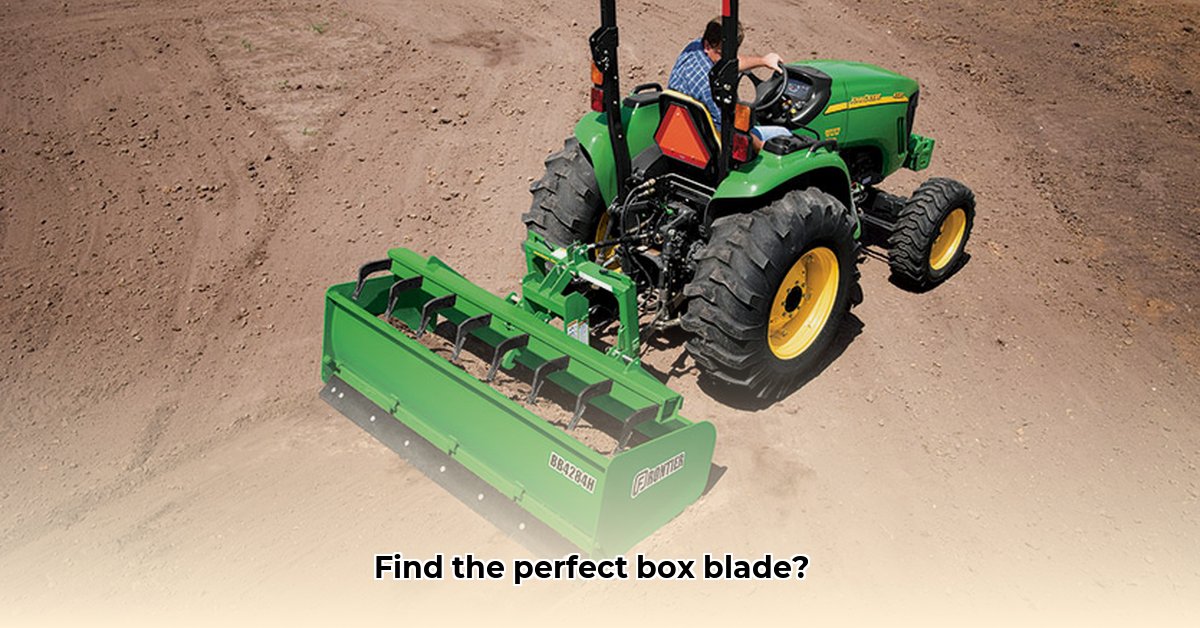
Choosing the Right Box Blade: A Detailed Guide
Selecting the right box blade for your tractor is a crucial decision impacting efficiency and longevity. This guide helps you navigate the choices, focusing on factors like tractor horsepower, soil type, intended use, and budget. We'll also compare high-end and budget options, highlighting the long-term value of premium models. For more on tractor implements, see this helpful guide: Tractor Implements Guide.
Understanding the Basics: A box blade is a versatile agricultural implement used for grading, land clearing, snow removal, and other tasks. It consists of a rectangular frame with adjustable blades, often featuring ripper shanks (teeth) for soil penetration.
Key Factors to Consider
Tractor Horsepower: This is paramount. A box blade that's too heavy for your tractor will struggle, potentially damaging your equipment. Consult your tractor's manual for weight capacity recommendations. A 25 HP tractor will struggle with a heavy-duty box blade designed for 50+ HP tractors. Match the weight and size of the box blade to your tractor's capabilities. "Underpowering" your box blade is a common mistake leading to decreased efficiency and potential equipment damage.
Soil Type: Hard, rocky soil requires a more robust box blade, ideally one with strong, easily adjustable ripper shanks. Softer soil might be manageable with a lighter-duty model. Using a heavy-duty box blade on lighter soil is inefficient, while using a light-duty model on rock-filled soil can lead to damage. The type of soil directly dictates the required blade strength and ripper shank configuration.
Intended Use: Do you need a box blade for light grading, aggressive land clearing, or snow removal? Each application demands a specific blade design and features. For instance, snow removal might necessitate a modified blade angle and shape. Identifying the primary use case helps determine the appropriate blade size, features, and material.
Budget: High-end box blades, often using Hardox steel (a high-strength, abrasion-resistant steel), offer superior durability and longevity. While they involve a higher initial investment, their long-term cost is often lower due to reduced maintenance and longer lifespan. Budget-friendly options exist, but typically compromise on durability and require more frequent repairs. Balancing initial cost with long-term maintenance and replacement costs is crucial.
High-End vs. Budget Box Blades: A Comparison
| Feature | High-End (e.g., EA) | Budget |
|---|---|---|
| Material | Typically Hardox steel, US-made components | Lower-grade steel, often imported components |
| Ripper Shanks | Robust, easy to adjust | Less robust, possibly difficult to adjust |
| Build Quality | Precision manufacturing, rigorous quality control | Variable quality control |
| Long-Term Cost | Higher initial cost, lower long-term expenses | Lower initial cost, higher long-term expenses |
Operating and Maintaining Your Box Blade: Best Practices
Proper operation and regular maintenance are essential for prolonging your box blade's lifespan and ensuring safe operation.
Pre-Operation Checks: Always inspect the blade for damage, ensure all bolts are tight, and lubricate moving parts before each use. This preventative measure significantly reduces the risk of equipment failures during operation.
Adjustments: High-end models provide easy adjustments to blade angle and ripper shank depth for optimal performance in varying conditions. Adjustments allow for effective grading, land clearing, and other tasks.
Operation Techniques: Begin work at a slow pace, gradually increasing speed as you gain confidence. Maintain awareness of your surroundings to avoid obstacles and maintain a safe working environment at all times.
Regular Maintenance: Regularly inspect for wear and tear, particularly on cutting edges and ripper shanks. Promptly replace worn parts to prevent further damage. Ignoring maintenance significantly shortens the lifespan and increases the long-term costs.
Troubleshooting Common Issues
- Blade Not Cutting Deep Enough: Adjust the blade angle or add weight to the box blade.
- Excessive Vibration: Check for loose bolts or misalignment.
- Bent Ripper Shanks: This could indicate the blade is unsuitable for the soil type or that the box blade is overloaded.
Case Studies: Real-World Examples
Farmers using high-end box blades report significantly less maintenance and longer lifespans compared to those using budget models. This demonstrates that investing in quality components offers long-term savings.
Summary and Recommendations
Choosing the right box blade involves careful consideration of your tractor's power, soil type, intended use, and budget. High-end models offer superior durability and long-term value, although they involve a higher upfront cost. Prioritizing regular maintenance is crucial for maximizing your box blade's lifespan and efficiency. Remember: Selecting the appropriate box blade is an investment that enhances productivity and longevity.